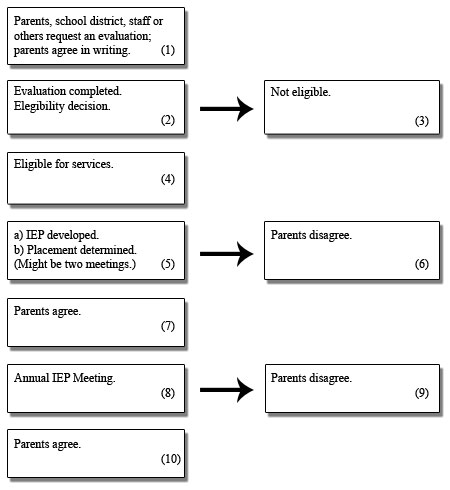An overview for parents
The chart below offers an overview of the special education process. It is not designed to show all steps or the specific details. It shows what happens from the time a child is referred for evaluation and is identified as having a disability, through the development of an individualized educationprogram (IEP).
The process begins when someone (school staff, parents, etc.) makes a referral for an initial evaluation.An explanation of each numbered area follows the chart.

How the process works
1. Parents, school personnel, students, or others may make a request for evaluation. If you request an evaluation to determine whether your child has a disability and needs special education, the school district must complete a full and individual evaluation. If it refuses to conduct the evaluation, it must give you appropriate notice and letyou know your rights.
You must give permission in writing for an initial (first time) evaluation and for any tests that are completed as part of a reevaluation.
2. A team of qualified professionals and you will review the results of the evaluation, and determine if your child iseligible for special education services.
3. If your child is not eligible, you will be appropriately notified and the process stops. However, you have a right to disagree with the results of the evaluation or the eligibility decision.
If you disagree with the results of an evaluation, you have a right to an Independent Educational Evaluation (IEE). Someone who does not work for the school district completes the IEE. The school district must pay for the IEE or show at an impartial due process hearing (see Key Terms below) that its evaluation is appropriate.
4. If you and the school district agree that your child is eligible for services, you and the school staff will plan your child’s Individualized Education Program (IEP), at an IEP team meeting. You are an equal member of this team. Some states may have a different name for the IEP team meeting.
5. The IEP lists any special services your child needs, including goals your child is expected to achieve in one year, and objectives or benchmarks to note progress. The team determines what services are in the IEP, as well as the location of those services and modifications. At times, the IEP and placement decisions will take place at one meeting. At other times, placement may be made at a separate meeting (usually called a placement meeting.)
Placement for your child must be in the Least Restrictive Environment (LRE) appropriate to your child’s needs. He or she will be placed in the regular classroom to receive services unless the IEP team determines that, even with special additional aids and services, the child cannot be successful there. You are part of any group that decides what services your child will receive and where they will be provided.
6. If you disagree with the IEP and/or the proposed placement, you should first try to work out an agreement with your child’s IEP team. If you still disagree, you can use your due process rights.
7. If you agree with the IEP and placement, your child will receive the services that are written into the IEP. You will receive reports on your child’s progress at least as often as parents are given reports on their children who do not have disabilities. You can request that the IEP team meet if reports show that changes need to be made in the IEP.
8. The IEP team meets at least once per year to discuss progress and write any new goals or services into the IEP. As a parent, you can agree or disagree with the proposed changes. If you disagree, you should do so in writing.
9. If you disagree with any changes in the IEP, your child will continue to receive the services listed in the previous IEP until you and school staff reach agreement. You should discuss your concerns with the other members of the IEP team. If you continue to disagree with the IEP, you have several options, including asking for additional testing or an Independent Educational Evaluation (IEE), or resolving the disagreement using due process.
10. Your child will continue to receive special education services if the team agrees that the services are needed. A reevaluation is completed at least once every three years, unless you and the school district agree that reevaluation is not needed, to see if your child continues to be eligible for special education services and to decide what services he or she needs.
Key terms
Due process protects the right of parents to have input into their child’s educational program and to take steps to resolve disagreements. When parents and school districts disagree with one another, they may ask for an impartial hearing to resolve issues. Mediation must also be available.
Mediation is a meeting between parents and the school district with an impartial person, called a mediator, who helps both sides come to an agreement that each finds acceptable.
An impartial due process hearing is a meeting between parents and the school district. Each side presents its position, and a hearing officer decides what the appropriate educational program is, based on requirements in law.
School districts must give parents a written copy of special education procedural safeguards. This document outlines the steps for due process hearings and mediation. A copy of their procedural safeguards must be given to parents once each year, except that a copy also shall be given to them:
- upon initial referral or parental request for evaluation;
- upon the first occurrence of the filing of a complaint under subsection (b)(6); and
- upon their request.
